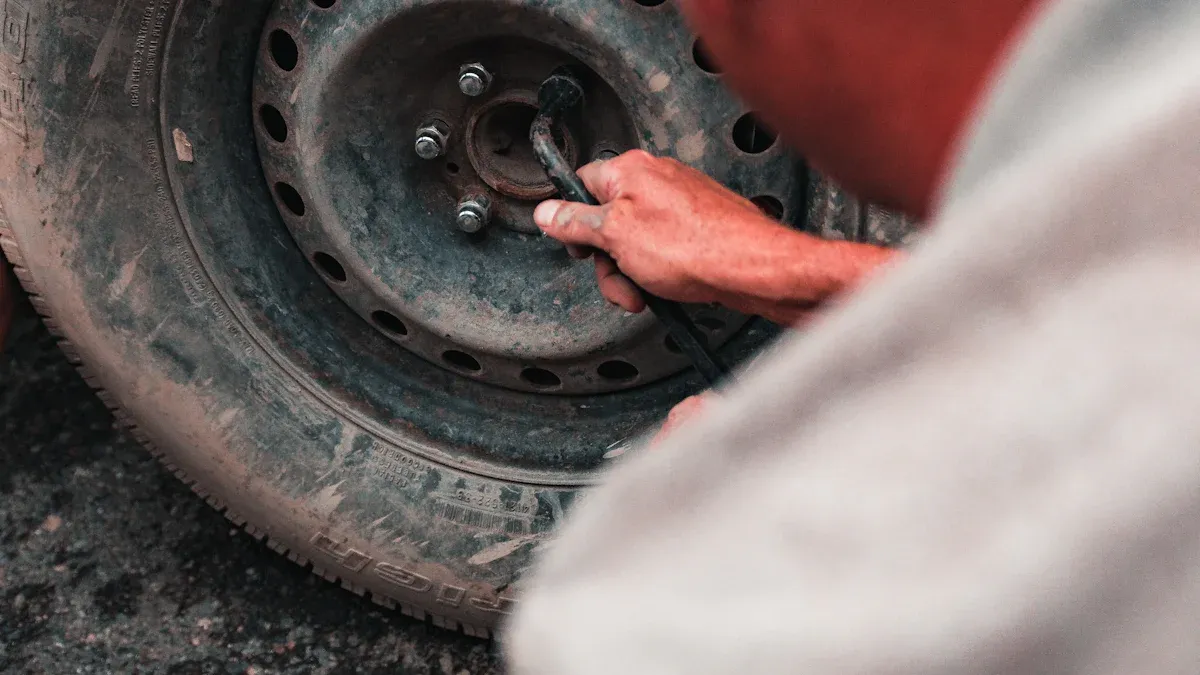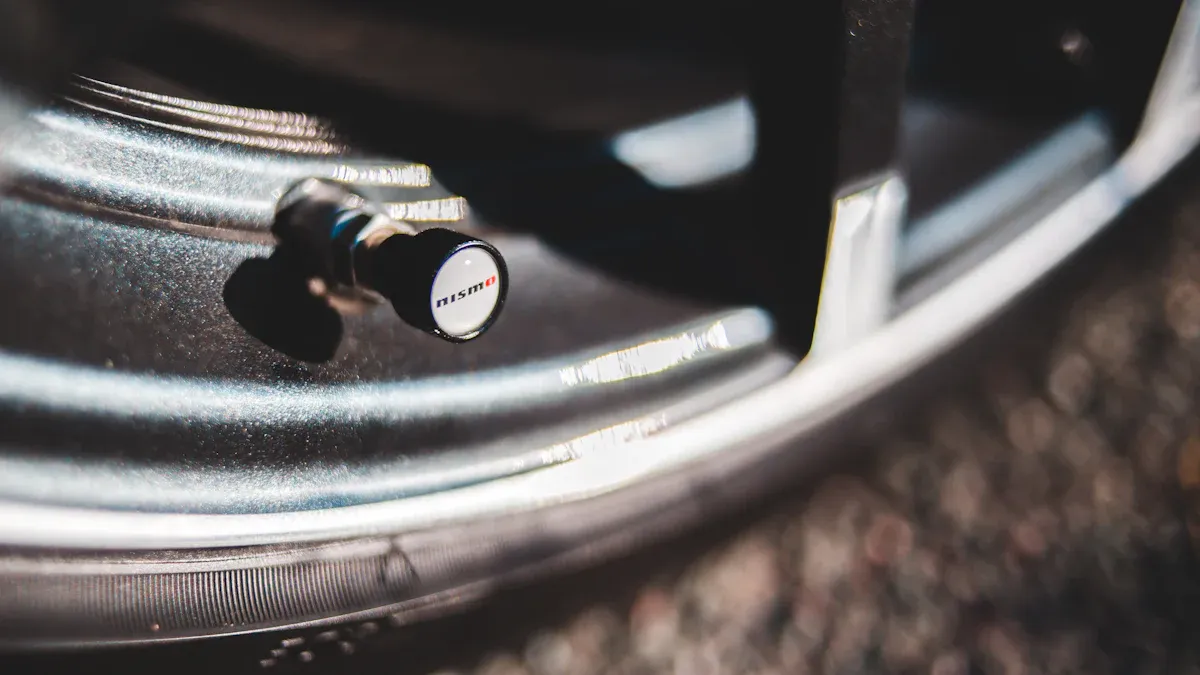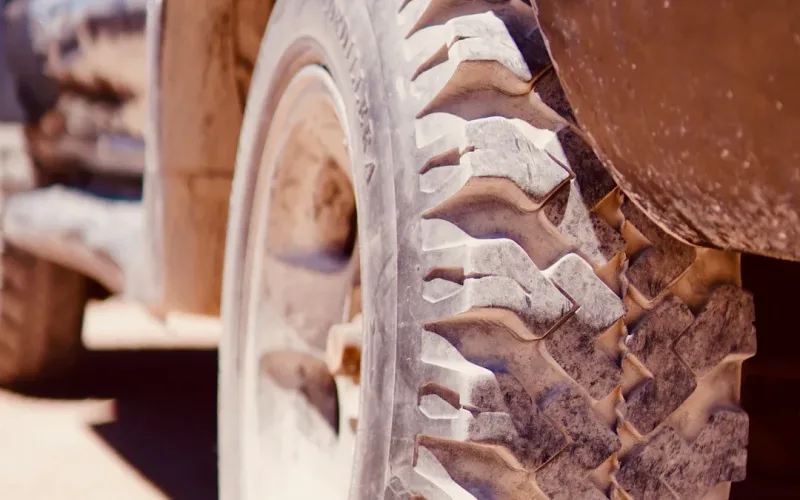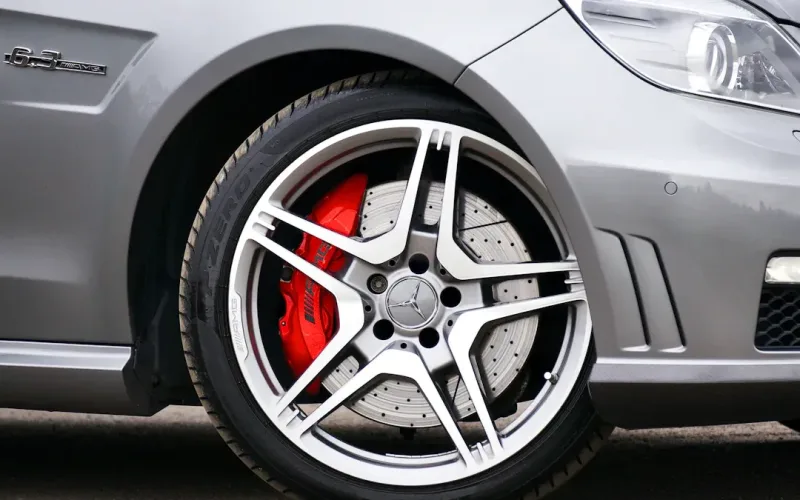

admin1
July 29, 2025
Are Tire Valve Covers Necessary for Safe Driving in 2025

You might think tire valve covers are just small parts, but they play a big role in tire safety. These covers keep your tire’s valve stem safe from dirt, water, and other debris. If you skip this simple protection, your tire can lose air or even get damaged. You could end up with a flat tire or find yourself stuck on the side of the road.
- Tire valve covers help you avoid costly repairs.
- They keep your tires in top shape for every drive.
How Tire Valve Covers Protect Your Tire

Preventing Air Leaks with Tire Valve Caps
You might not notice it, but tire valve caps do a lot to keep your tires safe. When you screw a tire valve cap onto the valve stem, you create a barrier that helps prevent air leaks. Even a tiny leak can cause your tire to lose pressure over time. If you drive with low tire pressure, your car will not handle well, and your tires will wear out faster.
Tire valve caps act as the first line of defense against leaks. They stop dirt, dust, and water from getting inside the valve stem. If these things get in, they can cause the valve to stick open or not seal right. That leads to air leakage and more trips to the gas station to fill up your tires. You want to avoid that hassle, right?
Tip: Always check your tire valve caps after getting new tires or a tire rotation. Sometimes, mechanics forget to put them back on.
Here’s a quick look at what happens when you use tire valve caps:
| With Tire Valve Caps | Without Tire Valve Caps |
|---|---|
| Less chance of leaks | More chance of leaks |
| Valve stays clean | Valve gets dirty |
| Tire holds air | Tire loses air |
Shielding the Valve Stem from Dirt and Corrosion
Tire valve covers do more than just prevent air leaks. They also help with protecting valve stems from dirt and corrosion. When you drive, your tires kick up all sorts of debris. Rocks, sand, and even road salt can get into the valve stem if you don’t have a tire valve cap in place.
If dirt or water gets inside, it can cause the metal parts of the valve stem to rust. Corrosion makes the valve weak and can lead to leaks. In some cases, the valve stem might even break off. That’s a big problem because you could lose all the air in your tire at once.
You want your tires to last as long as possible. By using tire valve covers, you add an extra layer of protection. This simple step helps you avoid costly repairs and keeps your tires working their best.
- Tire valve caps keep out water and salt.
- They stop dirt from clogging the valve.
- They help maintain tire longevity by protecting valve stems.
Maintaining Tire Pressure and Performance
Keeping your tires properly inflated is key for safe driving. Tire valve caps help you maintain tire pressure by stopping leaks and keeping the valve stem in good shape. When your tires have consistent tire pressure, you get better gas mileage, smoother rides, and longer-lasting tires.
If you ignore your tire valve covers, you risk losing air without even knowing it. That means your tires might not be properly inflated. Underinflated tires can make your car harder to control and can even cause a blowout.
Note: The National Highway Traffic Safety Administration (NHTSA) says that driving on underinflated tires increases your risk of a crash. You can avoid this risk by checking your tire valve caps and making sure they are tight.
Here’s why tire valve covers matter for tire performance:
- They help maintain tire pressure by preventing leaks.
- They support consistent tire pressure, which improves tire longevity.
- They give you peace of mind, knowing your tires are protected.
So, don’t overlook these small but mighty parts. Tire valve covers, tire valve caps, and tire caps all play a big role in preventing air leakage, protecting valve stems, and keeping your tires in top shape.
Risks of Missing or Damaged Tire Valve Covers
Increased Risk of Tire Air Loss
You might not notice when a tire valve cap goes missing, but it can lead to problems over time. Without this small piece, your valve stem faces more exposure to dirt and moisture. These things can sneak inside and cause the valve to stick or even corrode. When that happens, you could see slow leaks that make your tires lose air little by little.
Take a look at the main causes of tire air loss and how missing tire valve caps fit in:
| Cause of Tire Air Loss | Explanation | Significance of Missing Tire Valve Caps |
|---|---|---|
| Improperly functioning valve stem | Damaged or old valve stems cause slow leaks (1-3 PSI loss over time). | Valve caps keep dirt and moisture out, helping prevent valve damage. |
| Temperature fluctuations | Cold weather shrinks air inside your tires, dropping pressure by about 1 PSI per 10°F decrease. | Valve caps stop moisture from freezing inside the valve. |
| Nails or sharp objects | Punctures cause fast leaks (2-3 PSI per day). | Valve caps do not prevent punctures. |
| Damaged or bent wheels | Bent wheels cause leaks and vibration. | Valve caps do not affect this cause. |
You can see that missing tire valve caps do not directly cause air leakage, but they do play a big part in protecting valve stems. If you let dirt or water get inside, your valve can start leaking. Over time, this leads to loss of tire pressure and more trips to the air pump. Keeping your tire valve covers in place is a simple way to avoid these slow leaks and keep your tires properly inflated.
Tip: If you notice your tires keep losing air, check for missing or damaged tire valve caps first. It’s an easy fix that can save you money and trouble.
Exposure to Debris and Valve Stem Damage
When you drive without tire valve caps, you leave your valve stem open to everything the road throws at it. Dirt, sand, and even tiny rocks can get inside. Water can sneak in, too, especially on rainy days or when you drive through puddles. Over time, this exposure can cause the metal parts of your valve stem to rust or corrode.
Rusty or damaged valve stems can’t seal as well. That means more leaks and more chances for air to escape. You might not see the damage right away, but it builds up. Protecting valve stems with tire valve covers keeps out the debris and moisture that cause these problems. This simple protection helps your tires last longer and keeps you from dealing with sudden tire leaks.
- Tire valve caps block out dirt and water.
- They help prevent corrosion and keep your valve stem working right.
- You get better tire longevity and fewer surprise leaks.
Potential for Tire Failure and Unsafe Driving
Ignoring missing or damaged tire valve covers can lead to bigger problems than just slow leaks. If your valve stem gets damaged, you could face a sudden loss of tire pressure. That can make your car harder to control, especially at high speeds. In the worst case, you might even have a tire blowout.
Driving on underinflated tires puts you and others at risk. Your car won’t handle as well, and your stopping distance gets longer. You also wear out your tires faster, which means you’ll need to replace them sooner. Keeping your tire valve caps in good shape helps you avoid these dangers by preventing air leakage and supporting consistent tire pressure.
🚗 Remember: A small part like a tire valve cap can make a big difference in your safety on the road. Don’t skip this easy step in tire care.
If you want your tires to last and your drives to stay safe, always check your tire valve covers. Replace any that are missing or damaged. This quick habit protects your tires, keeps you properly inflated, and helps you avoid costly repairs.
Tire Valve Covers in 2025: New Materials and Safety Standards
Advances in Tire Valve Cap Technology
You might notice that tire valve covers look a bit different in 2025. Manufacturers now use stronger and lighter materials, like advanced plastics and corrosion-resistant metals. These new materials help your tire valve covers last longer, even in tough weather. Some covers even have special seals to keep out water and dirt better than ever before.
You can also find covers with built-in sensors. These sensors check your tire pressure and send alerts if something goes wrong. You do not have to guess if your tires are safe. The technology does the work for you.
Tip: Choose valve covers made from high-quality materials. They protect your tires and save you money in the long run.
Updated Safety Standards for Tire Valve Covers
Safety rules for tire valve covers have changed in 2025. Now, covers must pass strict tests for strength, sealing, and durability. This means you get better protection for your tires. New standards also require covers to fit tightly on the valve stem, so they do not fall off while you drive.
You will see more products with certifications like ISO9001. These marks show that the covers meet global safety and quality standards. When you buy certified covers, you know your tires have the best protection.
Smart Tire Valve Covers and Tire Pressure Monitoring
Smart tire valve covers have become popular in 2025. These covers do more than just protect. They use sensors to track tire pressure, temperature, and even tread depth. You get real-time updates on your phone or car dashboard.
Here’s what smart tire valve covers can do for you:
- Measure tire pressure, temperature, and tread depth
- Send alerts if your tire loses air or gets too hot
- Connect to your car’s tire pressure monitoring system (TPMS)
- Use Bluetooth, RFID, or 5G for fast data sharing
- Help you schedule maintenance and keep your tires in top shape
Smart covers make it easy to spot problems early. You can avoid flat tires and keep your family safe. Many smart covers also resist water, dust, and chemicals, so they last longer. Some even use special batteries or energy from the tire’s movement to power the sensors.
🚗 Note: Smart tire valve covers help you catch leaks or heat problems before they become dangerous. They give you peace of mind every time you drive.
Practical Tips for Tire Valve Cover Maintenance and Replacement

How to Check Your Tire Valve Covers
You want your tires to last and keep you safe. Checking your tire valve caps is a simple part of tire maintenance that you can do at home. Here’s an easy way to make sure your tire valve covers are doing their job:
- Remove the tire’s valve cap before you check the air pressure.
- Press the pressure gauge firmly onto the valve stem. This helps prevent air from leaking out.
- Adjust the air pressure if you need to. Add or release air as needed.
- Put the valve cap back on right after you finish checking.
- Repeat these steps for every tire, including your spare.
Try to check your tire pressure when the tires are cold. This gives you the most accurate reading. Using a good pressure gauge helps you keep your tires at the right pressure, which is important for safety and performance.
🛠️ Tip: Make tire maintenance a habit. A quick check every month can help you avoid bigger problems down the road.
When and How to Replace Tire Valve Caps
Sometimes, you might notice a missing or damaged tire valve cap. If you see cracks, rust, or if the cap feels loose, it’s time for a replacement. You can find new tire valve caps at any auto parts store. Just twist off the old one and screw on the new cap by hand. Make sure it fits snugly but don’t force it.
If you lose a cap, replace it as soon as possible. Even a short drive without a cap can let dirt or water into the valve stem. Keeping all your tire valve caps in place is a small step that makes a big difference in tire maintenance.
🚗 Note: Always keep a few spare tire valve caps in your glove box. You never know when you’ll need one!
Choosing the Right Tire Valve Covers for Your Vehicle
Picking the right tire valve covers helps protect your tires and supports good tire maintenance. In 2025, you have more choices than ever. Here’s a quick guide to help you decide:
| Factor | Description |
|---|---|
| Material | Choose metal for tough weather or rough roads. Plastic works well in mild climates. |
| Features | Some tire valve caps show pressure or have LED lights for safety. |
| Compatibility | Make sure the cap fits your valve stem. Most are universal, but check your vehicle’s needs. |
| Quality | High-quality caps last longer and seal better against dirt and water. |
Think about your driving habits and where you live. If you want extra safety, look for tire caps with built-in indicators. Always pick quality products to keep your tires in top shape.
You might think tire valve covers are small, but they make a big difference for your safety. When you check your tire pressure and keep those covers in place, you help your tires last longer and avoid trouble on the road. Here’s what you can do to keep your tires in top shape:
- Check tire pressure often to spot problems early.
- Keep valve covers on to block dirt and moisture.
- Look for cracks or damage during routine checks.
These simple steps help you prevent air leaks and costly tire repairs. Stay safe and make tire care a habit!
FAQ
Do you really need tire valve covers for safe driving?
Yes, you do. Tire valve covers keep dirt and water out of the valve stem. This helps your tires hold air longer. You lower your risk of flat tires and sudden air loss by keeping the covers on.
How often should you replace tire valve covers?
Check your tire valve covers every month. Replace them if you see cracks, rust, or if they feel loose. If you lose one, put on a new cover right away. Keeping them in good shape helps your tires last longer.
Can you use any tire valve cover on your car?
Most tire valve covers fit standard valve stems. Some cars or bikes use special sizes. Always check your owner’s manual or ask a tire expert if you are not sure. Using the right cover gives you the best protection.
What are smart tire valve covers, and do you need them?
Smart tire valve covers have sensors that track tire pressure and temperature. They send alerts to your phone or car. You do not need them to drive safely, but they make it easier to spot problems early and keep your tires in top shape.





